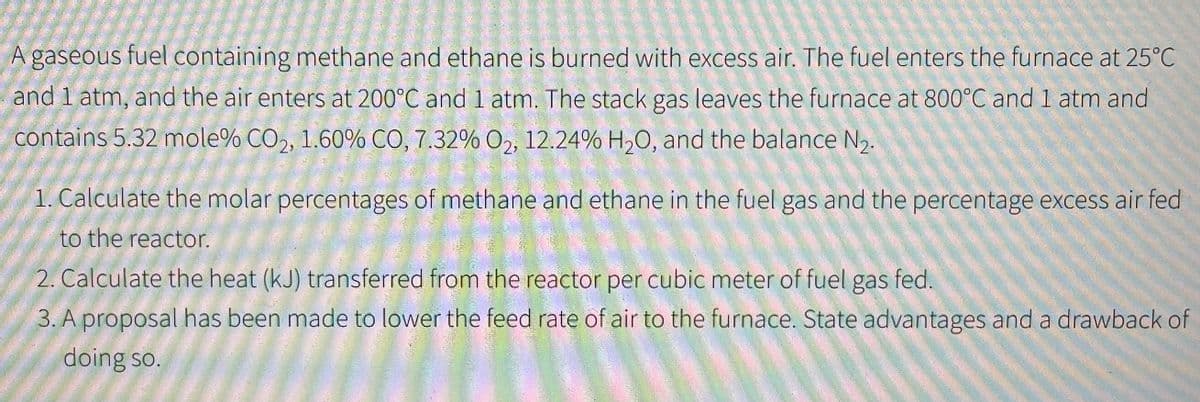A gaseous fuel containing methane and ethane is burned with excess air. The fuel enters the furnace at 25°C and 1 atm, and the air enters at 200°C and 1 atm. The stack gas leaves the furnace at 800°C and 1 atm and contains 5.32 mole% CO₂, 1.60% CO, 7.32% O₂, 12.24% H₂O, and the balance N₂. 1. Calculate the molar percentages of methane and ethane in the fuel gas and the percentage excess air fed to the reactor. 2. Calculate the heat (kJ) transferred from the reactor per cubic meter of fuel gas fed. 3. A proposal has been made to lower the feed rate of air to the furnace. State advantages and a drawback of doing so.
A gaseous fuel containing methane and ethane is burned with excess air. The fuel enters the furnace at 25°C and 1 atm, and the air enters at 200°C and 1 atm. The stack gas leaves the furnace at 800°C and 1 atm and contains 5.32 mole% CO₂, 1.60% CO, 7.32% O₂, 12.24% H₂O, and the balance N₂. 1. Calculate the molar percentages of methane and ethane in the fuel gas and the percentage excess air fed to the reactor. 2. Calculate the heat (kJ) transferred from the reactor per cubic meter of fuel gas fed. 3. A proposal has been made to lower the feed rate of air to the furnace. State advantages and a drawback of doing so.
Chemistry
10th Edition
ISBN:9781305957404
Author:Steven S. Zumdahl, Susan A. Zumdahl, Donald J. DeCoste
Publisher:Steven S. Zumdahl, Susan A. Zumdahl, Donald J. DeCoste
Chapter1: Chemical Foundations
Section: Chapter Questions
Problem 1RQ: Define and explain the differences between the following terms. a. law and theory b. theory and...
Related questions
Question

Transcribed Image Text:A gaseous fuel containing methane and ethane is burned with excess air. The fuel enters the furnace at 25°C
and 1 atm, and the air enters at 200°C and 1 atm. The stack gas leaves the furnace at 800°C and 1 atm and
contains 5.32 mole% CO2, 1.60% CO, 7.32% O₂, 12.24% H₂O, and the balance ₂.
1. Calculate the molar percentages of methane and ethane in the fuel gas and the percentage excess air fed
to the reactor.
2. Calculate the heat (kJ) transferred from the reactor per cubic meter of fuel gas fed.
3. A proposal has been made to lower the feed rate of air to the furnace. State advantages and a drawback of
doing so.
Expert Solution
This question has been solved!
Explore an expertly crafted, step-by-step solution for a thorough understanding of key concepts.
Step by step
Solved in 3 steps with 3 images

Knowledge Booster
Learn more about
Need a deep-dive on the concept behind this application? Look no further. Learn more about this topic, chemistry and related others by exploring similar questions and additional content below.Recommended textbooks for you

Chemistry
Chemistry
ISBN:
9781305957404
Author:
Steven S. Zumdahl, Susan A. Zumdahl, Donald J. DeCoste
Publisher:
Cengage Learning

Chemistry
Chemistry
ISBN:
9781259911156
Author:
Raymond Chang Dr., Jason Overby Professor
Publisher:
McGraw-Hill Education

Principles of Instrumental Analysis
Chemistry
ISBN:
9781305577213
Author:
Douglas A. Skoog, F. James Holler, Stanley R. Crouch
Publisher:
Cengage Learning

Chemistry
Chemistry
ISBN:
9781305957404
Author:
Steven S. Zumdahl, Susan A. Zumdahl, Donald J. DeCoste
Publisher:
Cengage Learning

Chemistry
Chemistry
ISBN:
9781259911156
Author:
Raymond Chang Dr., Jason Overby Professor
Publisher:
McGraw-Hill Education

Principles of Instrumental Analysis
Chemistry
ISBN:
9781305577213
Author:
Douglas A. Skoog, F. James Holler, Stanley R. Crouch
Publisher:
Cengage Learning

Organic Chemistry
Chemistry
ISBN:
9780078021558
Author:
Janice Gorzynski Smith Dr.
Publisher:
McGraw-Hill Education

Chemistry: Principles and Reactions
Chemistry
ISBN:
9781305079373
Author:
William L. Masterton, Cecile N. Hurley
Publisher:
Cengage Learning

Elementary Principles of Chemical Processes, Bind…
Chemistry
ISBN:
9781118431221
Author:
Richard M. Felder, Ronald W. Rousseau, Lisa G. Bullard
Publisher:
WILEY